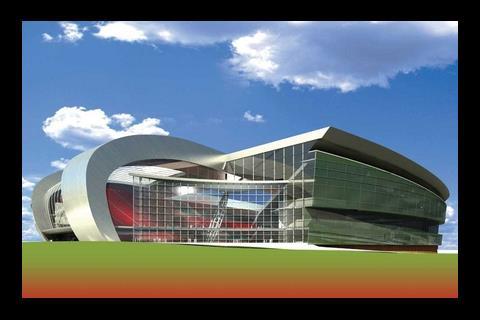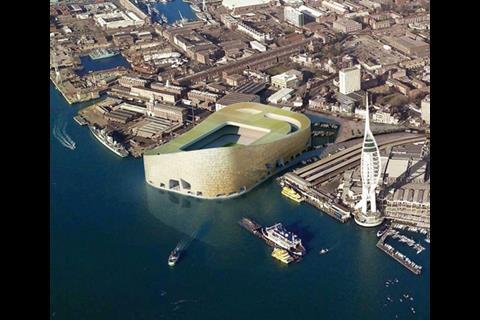Reds boss tells board to sign ‘classy’ cost consultant
Forget Tevez’s transfer and Terry’s dodgy knee, the big news on the back pages during the close season has been the stadium-building plans of the big clubs. As the new season kicks off, Building pundit Katie Puckett takes a look at the teams that are as busy chasing cost consultants as silky-skilled Spanish strikers
‘There’s too much money flooding into English football.” It’s a common refrain among fans – but it’s turning out to be excellent news for construction.
Last week, Liverpool FC unveiled proposals for a £300m stadium at Stanley Park, dividing fans of football and architecture alike with an ultra-modern design. Their Premiership rivals Everton and Portsmouth have already announced redevelopment plans, as have League One’s Nottingham Forest. Other clubs are certain to follow suit. Aston Villa are making plans to redevelop their home at Villa Park and Spurs say they’re looking at options both within and outside their home borough of Haringey, north London.
“Every football club is looking to build something new,” says Barry Winterton, who heads the sports division at Franklin + Andrews. “Any football club that hasn’t recently redeveloped or built a new stadium will be looking at opportunities.”
For club owners, stadium redevelopment is the path to untold riches in extra gate receipts, corporate hospitality and sponsorship opportunities. And as building mania sweeps the Premiership, those clubs who haven’t announced ground upgrades are under pressure not to be left behind.
Fortunately, they’ve got plenty of money to spend. “The revenues are huge,” says Chris Lee, head of professional sports at Barclays, pointing out that Premiership clubs will earn just over £2.5bn over the next three years from television contracts alone.
Any club that hasn’t recently redeveloped or built a new stadium will be looking at opportunities
Barry Winterton, Franklin + Andrews
“Eight of the 20 Premiership clubs are now owned by foreign investors. They’ve got the money to develop and the demand from spectators is massive. Clubs have got waiting lists for season tickets, but if you can expand the ground, you get more people in and more revenues, which makes you more attractive to sponsors, so it snowballs.”
Lee points out that Arsenal were selling out their old 38,000-capacity stadium every week, and now that they have moved to the 60,000-capacity Emirates Stadium, they’re still selling it out every week. With such a precedent, it’s not surprising that for the more successful clubs, upping the stadium capacity is a very appealing prospect. Old Trafford, the much-expanded home of the 2007 champions Manchester United, currently seats more than 76,000 – the highest gate in the Premiership. Anfield, Liverpool’s current home, holds just over 45,000. Its proposed new stadium, by contrast, is designed to seat 60,000 to start with, and could be adapted to fit 76,000 if local transport is improved.
And it’s not just about size. “The designs are improving all the time,” says James Woodrough, the Davis Langdon partner who heads its sports team. If you can make your stadium into an icon, he adds, it will not do your commercial prospects any harm. Liverpool’s proposed stadium, designed by US architect HKS, is undeniably world-class. Portsmouth have signed up starchitect Herzog & de Meuron and, like Arsenal’s Emirates stadium, are aiming to put the club at the centre of a gargantuan regeneration scheme.
Such world-class design may not always meet with fans’ approval, however, particularly when it means ever-expanding hospitality areas for Sunderland manager Roy Keane’s hated “prawn sandwich brigade”. Arsenal fans may claim all the corporate schmoozing dampens the mood at the 60,000-seat Emirates, but it goes a long way towards paying the wages of players such as Cesc Fàbregas and Robin van Persie. Renting one of the 150 boxes at the Emirates Stadium starts at £65,000 a year.
“Demand is increasing for better hospitality and a lot more hospitality,” says Woodrough. “If you go round some of the older grounds, they’re well off track compared to what the new stadiums have got.” Everton’s proposed stadium in Kirkby includes 3,000 extra corporate places and 40 new boxes. The club is also planning to cash in on selling the name of the stadium, following in the footsteps of Arsenal’s £100m, 15-year deal with Emirates Airlines.
For the influx of foreign billionaires buying up Premiership clubs, a new stadium is as high a priority as a 30-goals-a-year striker. But for clubs without such riches, there are plenty of property developers willing to step in too. Many clubs are sitting on a goldmine, as the value of their city-centre ground has risen as the area around them develops. Everton expect to make £15m from the sale of Goodison Park.
Eight of the Premiership clubs are now owned by foreign investors. They’ve got the money to develop
Chris Lee, Barclays
“A lot of these clubs are looking to build new facilities but don’t have two brass ha’pennies to rub together,” says Winterton. “They’ve realised the land these football clubs sit on is very valuable and they can sell and move somewhere else. Often it’s done through a deal with a developer, where they come in and say: ‘If we build you a new stadium somewhere else, can I have your land?’”
Nottingham Forest, for example, want a new 50,000-seat “super stadium” in Clifton, south of the city. That’s pretty big for a League One team, but the club says it expects to be in the Premiership by the time it’s completed in 2014, and that they regularly attract crowds of more than 20,000 now anyway. They’re talking to housebuilder Wilson Bowden about a joint venture. “Nottingham Forest’s stadium was on a prime piece of land by the river, it’s crying out for residential,” notes Winterton.
Regeneration was a big feature of the Emirates scheme and Portsmouth and Everton hope to replicate its success (see box, left). Councils are realising a stadium can revive a depressed area, and that they can tack on community benefits such as public space and infrastructure. Include housing and everyone’s laughing - the luxury apartments in Arsenal’s listed Highbury stadium were sold off-plan starting at £290,000 for a studio flat.
It’s not only developers who are keen to help clubs move out. At MK Dons’ new ground in Milton Keynes, Asda and Ikea paid for the stadium and will open stores on the new site.
One problem the clubs may have is getting a contractor to build the largest of these projects in a busy market, with many sports specialists occupied with the 2012 Olympics. Most companies won’t bend over backwards to work for a one-off client and the football clubs themselves won’t be experienced enough to want to take all the risk, especially in the wake of Multiplex’s troubles at Wembley. “It’ll come down to terms and conditions,” says Winterton. “Gone are the days when anybody would buy the project to be involved in something so high profile.”
And if they get all that sorted out, there’s just those temperamental footballers to worry about …
Postscript
For more images of the latest football stadium plans, search www.building.co.uk/gallery
































No comments yet